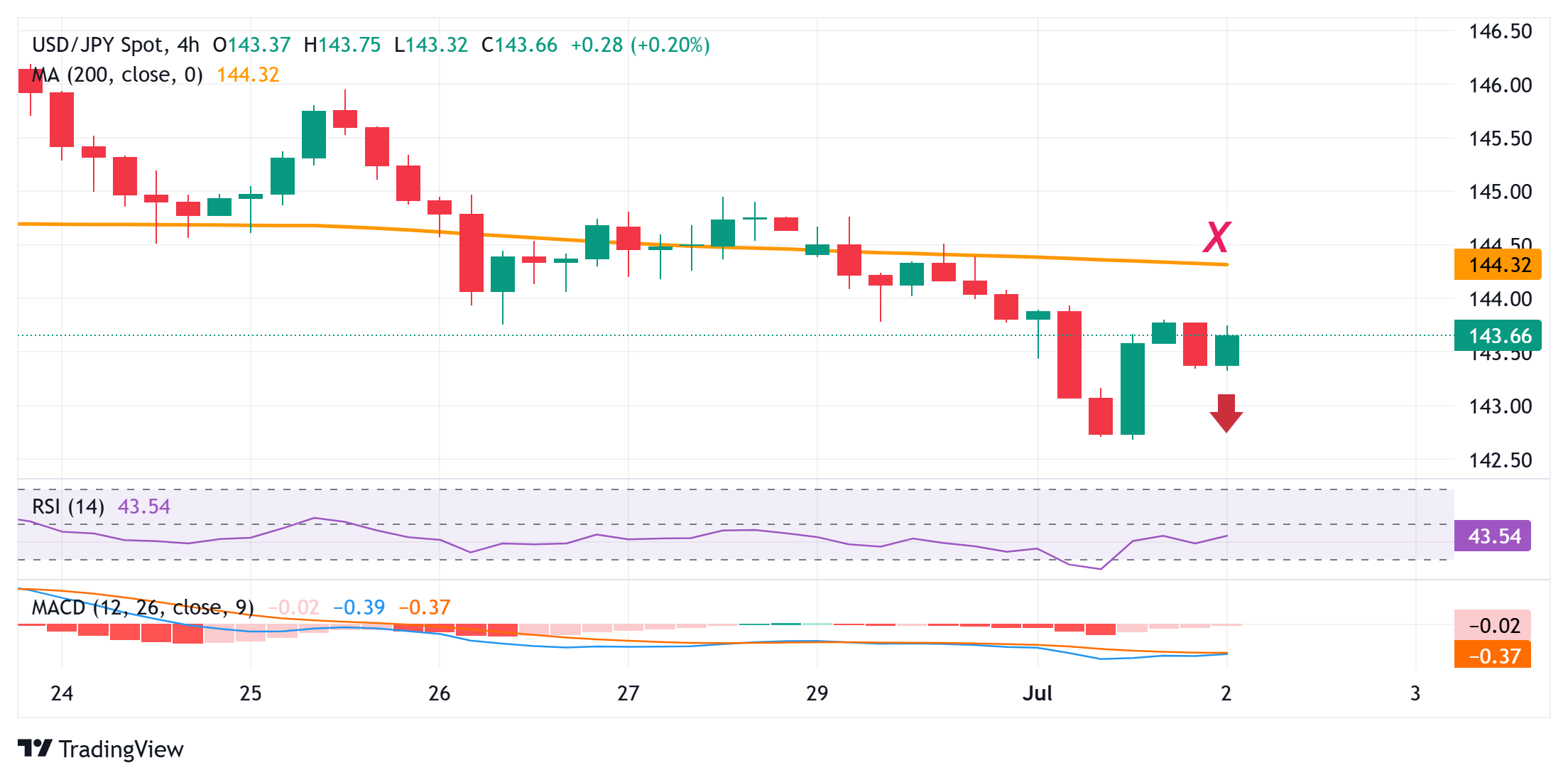- The Japanese Yen attracts some vendors while Trump raises doubts about an agreement between the US and Japan.
- A positive risk tone also undermines the JPY as a safe refuge and supports the USD/JPY.
- The divergent expectations between the BOJ and the Fed favor the bulls of the JPY and could limit the pair of currencies.
The Japanese Yen (JPY) slides downward during the Asian session on Wednesday and moves away from a maximum of almost a month reached in front of his US counterpart the day before. The president of the United States, Donald Trump, expressed skepticism about the possibility of reaching a commercial agreement with Japan and suggested that possible tariffs on Japanese imports would be higher than the 24% rate announced on April 2. This, together with the underlying bullish feeling, is considered to undermine the status of safe refuge of the JPY.
Meanwhile, the caution approach of the Bank of Japan (BOJ) to undo its ultra-flexible policy forced investors to delay their expectations of early rise in interest rates. However, investors seem convinced that the BOJ will remain in the path of standardization of monetary policy, since inflation has persistently exceeded its objective for almost three years. This could limit the losses of the JPY, which, together with the lack of purchases of the US dollar (USD), should contribute to limit the tentative recovery of the USD/JPY torque.
The Japanese yen slides down while Trump raises doubts about an agreement with Japan
- The president of the United States, Donald Trump, expressed frustration for the stagnant trade negotiations between the US and Japan and raised doubts about the possibility of reaching an agreement with Japan. In addition, Trump suggested that he could impose a 30% or 35% tariff on Japan imports, above the 24% tariff rate announced on April 2.
- The governor of the Bank of Japan, Kazuo Ueda, said Tuesday that although general inflation has been above 2% for almost three years, underlying inflation remains below the target. Ueda added that any future rise in rates will depend on the general dynamics of inflation, including salary growth and expectations.
- In addition, the new member of the Boj Board, Kazuyuki Masu, said Tuesday that the Central Bank should not rush the interest rates given the variety of economic risks. However, concerns about the growing inflationary pressure in Japan keep the door open to a rise in the Boj rates in 2025, especially if commercial risks are stabilized.
- In contrast, the president of the Federal Reserve (FED), Jerome Powell, said that the US Central Bank would have relaxed the monetary policy for this time if it were not for Trump’s tariff plan. When asked if Julio would be too soon for markets to expect a rate cut, Powell replied that he could not say it and that it would depend on the data.
- However, the operators still see a small possibility that the next reduction of rates by the Fed occurs in July and are valuing more than 75% probability of a rate cut at the September policy meeting. This, in turn, dragged the US dollar to its lowest level since February 2022 and should limit the USD/JPY torque.
- Meanwhile, the USM manufacturing PMI of the US showed on Tuesday that economic activity in the manufacturing sector contracted for the fourth consecutive month, although the contraction rate was slowed in June. In fact, the indicator rose to 49 from 48.5 in May, above the expectations of the market of 48.8.
- Separately, the US Labor Statistics Office (BLS) reported in the Employment and Labor Rotation (Jolts) survey that the number of job offers on the last business day of May was 7,769 million. This followed 7,395 million offers in April and was above the estimates of 7.3 million.
- The operators now expect the publication of the US ADP report on employment in the private sector to obtain a new impulse later on Wednesday. However, the attention remains focused on the monthly US employment details – popularly known as the Non -Agricultural Payroll (NFP) report – which will be published on Thursday.
The USD/JPY could attract new sellers around 144.00 and remain limited near the 200 SMA in H4

From a technical perspective, negative oscillators in the 4 -hour/day graphics suggest that any subsequent movement towards the 144.00 mark could be seen as a sales opportunity. This, in turn, should limit the USD/JPY pair near the simple mobile average (SMA) of 200 periods in the 4 -hour graph, currently located near the region of 144.35. Some purchases of continuation, which lead to a subsequent strength beyond the horizontal obstacle of 144.65, should allow SPOT prices to recover the psychological brand of 145.00.
On the contrary, the 143,40-143.35 area could offer some support before the round of 143.00 and the minimum of the previous night, around the region of 142.70-142.65. The inability to defend the aforementioned support levels will reaffirm the short-term negative bias and make the USD/JPY torque vulnerable to accelerate the fall towards the monthly minimum of May, around the region of 142.15-142.10. The downward trajectory could extend even more towards levels below 141.00 in the short term.
FAQS tariffs
Although tariffs and taxes generate government income to finance public goods and services, they have several distinctions. Tariffs are paid in advance in the entrance port, while taxes are paid at the time of purchase. Taxes are imposed on individual taxpayers and companies, while tariffs are paid by importers.
There are two schools of thought among economists regarding the use of tariffs. While some argue that tariffs are necessary to protect national industries and address commercial imbalances, others see them as a harmful tool that could potentially increase long -term prices and bring to a harmful commercial war by promoting reciprocal tariffs.
During the election campaign for the presidential elections of November 2024, Donald Trump made it clear that he intends to use tariffs to support the US economy. In 2024, Mexico, China and Canada represented 42% of the total US imports in this period, Mexico stood out as the main exporter with 466.6 billion dollars, according to the US Census Office, therefore, Trump wants to focus on these three nations by imposing tariffs. It also plans to use the income generated through tariffs to reduce personal income taxes.
Source: Fx Street
I am Joshua Winder, a senior-level journalist and editor at World Stock Market. I specialize in covering news related to the stock market and economic trends. With more than 8 years of experience in this field, I have become an expert in financial reporting.







